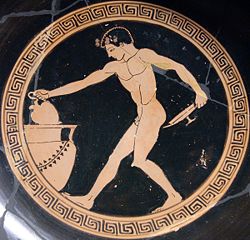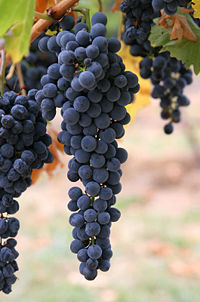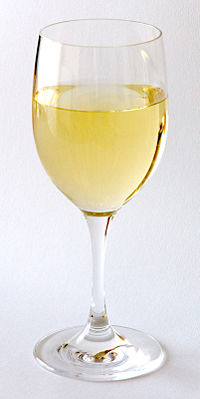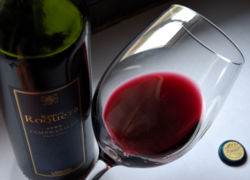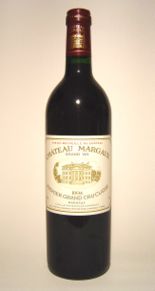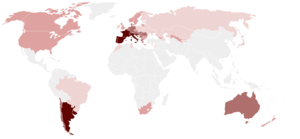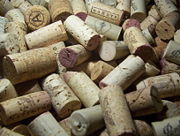Wine
2008/9 Schools Wikipedia Selection. Related subjects: Drink
Wine is an alcoholic beverage made from the fermentation of grape juice. The natural chemical balance of grapes is such that they can ferment without the addition of sugars, acids, enzymes or other nutrients. Wine is produced by fermenting crushed grapes using various types of yeast which consume the sugars found in the grapes and convert them into alcohol. Various varieties of grapes and strains of yeasts are used depending on the types of wine produced.
Although other fruits such as apples and berries can also be fermented, the resultant "wines" are normally named after the fruit from which they are produced (for example, apple wine or elderberry wine) and are generically known as fruit or country wine. Others, such as barley wine and rice wine (e.g. sake), are made from starch-based materials and resemble beer and spirit more than wine, while ginger wine is fortified with brandy. In these cases, the use of the term "wine" is a reference to the higher alcohol content, rather than production process. The commercial use of the English word "wine" (and its equivalent in other languages) is protected by law in many jurisdictions.
Wine has a rich history dating back to around 6000 BC and is thought to have originated in areas now within the borders of Georgia and Iran. Wine probably appeared in Europe at about 4500 BC in what is now Bulgaria and Greece, and was very common in ancient Greece, Thrace and Rome. Wine has also played an important role in religion throughout history. The Greek god Dionysos and the Roman equivalent Bacchus represented wine, and the drink is also used in Christian and Jewish ceremonies such as the Eucharist and Kiddush.
The word "wine" derives from the Proto-Germanic *winam, an early borrowing from the Latin vinum, "wine" or "(grape) vine", itself derived from the Proto-Indo-European stem *win-o- (cf. Ancient Greek οῖνος - oînos, Aeolic Greek ϝοίνος - woinos). Similar words for wine or grapes are found in the Semitic languages (cf. Arabic ﻭﻳﻦ wayn) and in Georgian (ğvino); some consider the term to be a wanderwort, or "wandering word".
History
Archaeological evidence suggests that the earliest production of wine, made by fermenting grapes, took place in sites in Georgia and Iran, from as early as 6000 BC. These locations are all within the natural area of the European grapevine Vitis vinifera.
A 2003 report by archeologists indicates a possibility that grapes were used together with rice to produce mixed fermented beverages in China as early as 7000 BC. Pottery jars from the Neolithic site of Jiahu, Henan were found to contain traces of tartaric acid and other organic compounds commonly found in wine. However, other fruits indigenous to the region, such as hawthorn, could not be ruled out. If these beverages, which seem to be the precursors of rice wine, included grapes rather than other fruits, these grapes were of any of the several dozen indigenous wild species of grape in China, rather than from Vitis vinifera, which were introduced into China some 6000 years later.
The oldest known evidence of wine production in Europe is dated to 4500 BC and comes from archaeological sites in Greece. The same sites also contain the world’s earliest evidence of crushed grapes. In ancient Egypt, wine became a part of recorded history, playing an important role in ceremonial life. Traces of wine have also been found in China, dating from the second and first millennia BC.
In medieval Europe, the Roman Catholic Church was a staunch supporter of wine since it was necessary for the celebration of Mass. In places such as Germany, beer was banned and considered pagan and barbaric, while wine consumption was viewed as civilized and a sign of conversion to Christianity.
In the Islamic world, wine was forbidden during the Islamic Golden Age. After Geber and other Muslim chemists pioneered the distillation of wine, however, it was legalized for cosmetic and medical uses. In fact, the 10th-century Persian philosopher and scientist Al Biruni described recipes where herbs, minerals and even gemstones are mixed with wine for medicinal purposes. Wine became so revered and its effect so feared that elaborate theories were developed about which gemstones would best counteract its negative side effects.
Grape varieties
Wine is usually made from one or more varieties of the European species Vitis vinifera, such as Pinot Noir, Chardonnay, or Merlot. When one of these varieties is used as the predominant grape (usually defined by law as a minimum of 75 or 85%), the result is a varietal, as opposed to a blended, wine. Blended wines are not considered inferior to varietal wines; in fact, some of the world's most valued and expensive wines, from regions like Bordeaux and the Rhone Valley, are blended from different grape varieties of the same vintage.
Wine can also be made from other species of grape or from hybrids, created by the genetic crossing of two species. Vitis labrusca (of which the Concord grape is a cultivar), Vitis aestivalis, Vitis rupestris, Vitis rotundifolia and Vitis riparia are native North American grapes usually grown for consumption as fruit or for the production of grape juice, jam, or jelly, but sometimes made into wine.
Hybridization is not to be confused with the practice of grafting. Most of the world's vineyards are planted with European V. vinifera vines that have been grafted onto North American species rootstock. This is common practice because North American grape species are resistant to phylloxera, a root louse that eventually kills the vine. In the late 19th century, Europe's vineyards were devastated by the bug, leading to massive vine deaths and eventual replanting. Grafting is done in every wine-producing country of the world except for the Canary Islands, Chile and Argentina, which are the only ones that have not yet been exposed to the insect.
In the context of wine production, terroir is a concept that encompasses the varieties of grapes used, elevation and shape of the vineyard, type and chemistry of soil, climate and seasonal conditions, and the local yeast cultures. The range of possibilities here can result in great differences between wines, influencing the fermentation, finishing, and aging processes as well. Many wineries use growing and production methods that preserve or accentuate the aroma and taste influences of their unique terroir. However, flavor differences are not desirable for producers of mass-market table wine or other cheaper wines, where consistency is more important. Such producers will try to minimize differences in sources of grapes by using production techniques such as micro-oxygenation, tannin filtration, cross-flow filtration, thin film evaporation, and spinning cones.
Classification
Regulations govern the classification and sale of wine in many regions of the world. European wines tend to be classified by region (e.g. Bordeaux and Chianti), while non-European wines are most often classified by grape (e.g. Pinot Noir and Merlot). More and more, however, market recognition of particular regions is leading to their increased prominence on non-European wine labels. Examples of non-European recognized locales include: Napa Valley in California, Barossa Valley in Australia, Willamette Valley in Oregon, and Marlborough in New Zealand.
Some blended wine names are marketing terms, and the use of these names is governed by trademark or copyright law rather than by specific wine laws. For example, Meritage (sounds like "heritage") is generally a Bordeaux-style blend of Cabernet Sauvignon and Merlot, and may also include Cabernet Franc, Petit Verdot, and Malbec. Commercial use of the term "Meritage" is allowed only via licensing agreements with an organization called the "Meritage Association".
Europe classification
France has an appellation system based on the concept of terroir, with classifications which range from Vin de Table ("table wine") at the bottom, through Vin de Pays and Vin Délimité de Qualité Supérieure (VDQS) up to Appellation d'Origine Contrôlée (AOC). Portugal has something similar and, in fact, pioneered this technique back in 1756 with a royal charter which created the "Demarcated Douro Region" and regulated wine production and trade.. Germany did likewise in 2002, although their system has not yet achieved the authority of those of the other countries'. Spain and Italy have classifications which are based on a dual system of region of origin and quality of product.
Outside of Europe
New World wine—wines from outside of the traditional wine growing regions of Europe—tend to be classified by grape rather than by terroir or region of origin, although there have been non-official attempts to classify them by quality.
Vintages
A "vintage wine" is one made from grapes that were all or mostly grown in a single specified year, and labeled as such. (Most countries allow a vintage wine to include a portion of wine that is not from the labeled vintage.) Variations in a wine's character from year to year can include subtle differences in colour, palate, nose, body and development. Good quality red table wines in particular can improve in flavor with age if properly stored. Consequently, it is not uncommon for wine enthusiasts and traders to save bottles of an especially good vintage wine for future consumption.
In the United States, for a wine to be vintage dated and labeled with a country of origin or American Viticultural Area (AVA) (such as " Sonoma Valley"), it must contain at least 95% of its volume from grapes harvested in that year. If a wine is not labeled with a country of origin or AVA the percentage requirement is lowered to 85%.
Vintage wines are generally bottled in a single batch so that each bottle will have a similar taste. Climate can have a big impact on the character of a wine to the extent that different vintages from the same vineyard can vary dramatically in flavor and quality. Thus, vintage wines are produced to be individually characteristic of the vintage and to serve as the flagship wines of the producer. Superior vintages, from reputable producers and regions, will often fetch much higher prices than their average vintages. Some vintage wines, like Brunellos, are only made in better-than-average years.
Non-vintage wines can be blended from more than one vintage for consistency, a process which allows wine makers to keep a reliable market image and maintain sales even in bad years. One recent study suggests that for normal drinkers, vintage year may not be as significant to perceived wine quality as currently thought, although wine connoisseurs continue to place great importance on it.
Tasting
Wine tasting is the sensory examination and evaluation of wine. Wines may be classified by their effect on the drinker's palate. They are made up of chemical compounds which are similar or identical to those in fruits, vegetables, and spices. The sweetness of wine is determined by the amount of residual sugar in the wine after fermentation, relative to the acidity present in the wine. Dry wine, for example, has only a small amount of residual sugar. Inexperienced wine drinkers often tend to mistake the taste of ripe fruit for sweetness when, in fact, the wine in question is very dry.
Individual flavours may also be detected, due to the complex mix of organic molecules such as esters and terpenes that grape juice and wine can contain. Tasters often can distinguish between flavours characteristic of a specific grape (e.g., Chianti and sour cherry) and flavours that result from other factors in wine making, either intentional or not. The most typical intentional flavor elements in wine are those that are imparted by aging in oak casks; chocolate, vanilla, or coffee almost always come from the oak and not the grape itself.
Banana flavours ( isoamyl acetate) are the product of yeast metabolism, as are spoilage aromas such as sweaty, barnyard, band-aid ( 4-ethylphenol and 4-ethylguaiacol), and rotten egg ( hydrogen sulfide). Some varietals can also have a mineral flavor, because some salts are soluble in water (like limestone), and are absorbed by the wine.
Wine aroma comes from volatile compounds in the wine that are released into the air. Vaporization of these compounds can be sped up by twirling the wine glass or serving the wine at room temperature. For red wines that are already highly aromatic, like Chinon and Beaujolais, many people prefer them chilled.
Collecting
At the highest end, rare, super-premium wines are the most expensive of all food, and outstanding vintages from the best vineyards may sell for thousands of dollars per bottle. Such wines are considered by some to be Veblen goods—that is, goods for which demand increases instead of decreases as its price rises. The most common wines purchased for investment include those from Bordeaux, cult wines from California, and Vintage port. Characteristics of highly collectible wines include:
- A proven track record of holding well over time
- A drinking window plateau (i.e., the period for maturity and approachability) that is many years long
- A consensus amongst experts as to the quality of the wines
Investment in fine wine has attracted fraudsters who prey on their victims' ignorance of this sector of the wine market. Wine fraudsters often work by charging excessively high prices for off-vintage or lower-status wines from famous wine regions, while claiming that they are offering a sound investment unaffected by economic cycles. Like any investment, proper research is essential before investing. Counterfeiting of labels and bottles is another scam that is frequently encountered in auctions of famous wines such as 1982 Pétrus.
Production
Wine grapes grow almost exclusively between thirty and fifty degrees north or south of the equator. The world's southernmost vineyards are in the Central Otago region of New Zealand's South Island near the 45th parallel, and the northernmost are in Flen, Sweden, just north of the 59th parallel.
Exporting countries
Uses
Wine is a popular and important beverage that accompanies and enhances a wide range of European and Mediterranean-style cuisines, from the simple and traditional to the most sophisticated and complex. Wine is important in cuisine not just for its value as a beverage, but as a flavor agent, primarily in stocks and braising, since its acidity lends balance to rich savory or sweet dishes. Red, white and sparkling wines are the most popular, and are known as light wines because they are only 10–14% alcohol-content by volume. Apéritif and dessert wines contain 14–20% alcohol, and are sometimes fortified to make them richer and sweeter.
Some wine labels suggest opening the bottle and letting the wine "breathe" for a couple hours before serving, while others recommend drinking it immediately. Decanting—the act of pouring a wine into a special container just for breathing—is a controversial subject in wine. In addition to aeration, decanting with a filter allows one to remove bitter sediments that may have formed in the wine. Sediment is more common in older bottles but younger wines usually benefit more from aeration.
During aeration, the exposure of younger wines to air often "relaxes" the flavours and makes them taste smoother and better integrated in aroma, texture, and flavor. Older wines generally fade, or lose their character and flavor intensity, with extended aeration. Despite these general rules, breathing does not necessarily benefit all wines. Wine should be tasted as soon as it is opened to determine how long it should be aerated, if at all.
Religious uses
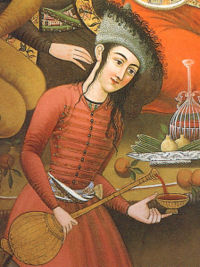
The use of wine in religious ceremonies is common to many cultures and regions. Libations often included wine, and the religious mysteries of Dionysus used wine as a sacramental entheogen to induce a mind-altering state.
Wine is an integral part of Jewish laws and traditions. The Kiddush is a blessing recited over wine or grape juice to sanctify the Shabbat or a Jewish holiday. On Pesach ( Passover) during the Seder, it is a Rabbinic obligation of men and women to drink four cups of wine. In the Tabernacle and in the Temple in Jerusalem, the libation of wine was part of the sacrificial service. Note that this does not mean that wine is a symbol of blood, a common misconception which contributes to the myth of the blood libel. A blessing over wine said before indulging in the drink is: "Baruch atah Hashem elokeinu melech ha-olam, boray p’ree hagafen"—"Praised be the Eternal, Ruler of the universe, who makes the fruit of the vine."
In Christianity, wine or grape juice is used in a sacred rite called the Eucharist, which originates in Gospel accounts of the Last Supper in which Jesus shared bread and wine with his disciples and commanded his followers to "do this in remembrance of me" ( Gospel of Luke 22:19). Beliefs about the nature of the Eucharist vary among denominations; Roman Catholics, for example, hold that the bread and wine are changed into the real body and blood of Christ in a process called transubstantiation.
Wine was used in the Eucharist by all Protestant groups until an alternative arose in 1869. Methodist minister-turned- dentist Thomas Bramwell Welch applied new pasteurization techniques to stop the natural fermentation process of grape juice. Some Christians who were part of the growing temperance movement pressed for a switch from wine to grape juice, and the substitution spread quickly over much of the United States. (However, in such rites the beverage is usually still called "wine" in accordance with scriptural references.) There remains an ongoing debate between some American Protestant denominations as to whether wine can and should be used for the Eucharist or allowed as a regular beverage.
The use of wine is forbidden under Islamic law. Iran used to have a thriving wine industry that disappeared after the Islamic Revolution in 1979.
Health effects
| Red table wine Nutritional value per 100 g (3.5 oz) |
|||||||||
|---|---|---|---|---|---|---|---|---|---|
| Energy 80 kcal 360 kJ | |||||||||
|
|||||||||
| 10.6 g alcohol is 13%vol. 100 g wine is approximately 100 ml (3.4 fl oz.) Sugar and alcohol content can vary. Source: USDA Nutrient database |
|||||||||
| Alcohol and Health |
|---|
| Short-term effects of alcohol |
| Long-term effects of alcohol |
| Alcohol and cardiovascular disease |
| Alcoholic liver disease |
| Alcoholic hepatitis |
| Alcohol and cancer |
| Alcohol and weight |
| Fetal alcohol syndrome |
| Fetal Alcohol Spectrum Disorder |
| Alcoholism |
| Blackout (alcohol-related amnesia) |
| Wernicke-Korsakoff syndrome |
| Recommended maximum intake |
The health effects of wine (and alcohol in general) are the subject of considerable ongoing study. In the United States, a boom in red wine consumption was initiated in the 1990s by the TV show 60 Minutes, and additional news reports on the French paradox. The French paradox refers to the comparatively lower incidence of coronary heart disease in France despite high levels of saturated fat in the traditional French diet. Epidemiologists suspect that this difference is due to the high consumption of wines by the French, but the scientific evidence for this theory is currently limited.
Population studies have observed a J curve association between wine consumption and the risk of heart disease. This means that abstainers and heavy drinkers have an elevated risk, while moderate drinkers have a lower risk. Studies have also found that moderate consumption of other alcoholic beverages may be cardioprotective, although the association is considerably stronger for wine. Also, the studies have found increased health benefits for red wine over white wine, included cancer protection. Researchers suspect that this may be because red wine contains more polyphenols than white wine.
A chemical in red wine called resveratrol has been shown to have both cardioprotective and chemoprotective effects in animal studies. Low doses of resveratrol in the diet of middle-aged mice has a widespread influence on the genetic levers of aging and may confer special protection on the heart. Specifically, low doses of resveratrol mimic the effects of what is known as caloric restriction - diets with 20-30 percent fewer calories than a typical diet. Resveratrol is produced naturally by grape skins in response to fungal infection, including exposure to yeast during fermentation. As white wine has minimal contact with grape skins during this process, it generally contains lower levels of the chemical. Other beneficial compounds in wine include other polyphenols, antioxidants, and flavonoids.
Red wines from south of France and from Sardinia in Italy have been found to have the highest levels of procyanidins, which are compounds in grape seeds suspected to be responsible for red wine's heart benefits. Red wines from these areas have between two and four times as much procyanidins as other red wines. Procyanidins suppress the synthesis of a peptide called endothelin-1 that constricts blood vessels.
A 2007 study found that both red and white wines are effective anti-bacterial agents against strains of Streptococcus. Interestingly, wine has traditionally been used to treat wounds in some parts of the world.
While evidence from both laboratory studies as well as epidemiological (observational) studies suggest a cardioprotective effect, no controlled studies have yet been completed that study the effect of alcoholic drinks on the risk of developing heart disease or stroke. Moreover, excessive consumption of alcohol can cause some diseases including cirrhosis of the liver and alcoholism. Also, the American Heart Association cautions people "not to start drinking ... if they do not already drink alcohol. Consult your doctor on the benefits and risks of consuming alcohol in moderation."
Based on the UK unit system for measuring alcoholic content, the average bottle of wine contains 9.4 units.
Sulphites are present in all wines and are formed as a natural product of the fermentation process. Additionally, many wine producers add sulfur dioxide in order to help preserve wine. The level of added sulfites varies, and some wines have been marketed with low sulfite content. Sulphites in wine are not a problem for most people, although some, particularly those with asthma, can have adverse reactions. Sulfur dioxide is also added to many other foods as well, such as dried apricots and orange juice.
Wine's effect on the brain has also been studied. Although some researchers have concluded that wine made from the Cabernet Sauvignon grape reduces the risk of Alzheimer's Disease, others have found that among diagnosed alcoholics, wine damages the hippocampus to a greater degree than other alcoholic beverages.
Packaging and storage
Most wines are sold in glass bottles and are sealed using corks. Recently, a growing number of wine producers have been using alternative closures such as screwcaps or synthetic plastic "corks". Some wines are packaged in heavy plastic bags within cardboard boxes, like breakfast cereal, and are called box wines or cask wine. One advantage of box wine is that it can stay fresh for up to a month after opening, while bottled wine will start to oxidize immediately. The wine in a box wine is typically accessed via a tap on the side of the box. In addition to being less expensive, alternative closures prevent cork taint, although they have been blamed for other problems such as excessive reduction.
Wine cellars (also called wine rooms if they are aboveground) are places designed specifically for the storage and aging of wine. In an active wine cellar, factors such as temperature and humidity are maintained by a climate control system. In contrast, passive wine cellars are not climate-controlled, and thus must be carefully located. Wine is a natural, perishable food product. Left exposed to heat, light, vibration or fluctuations in temperature and humidity, all types of wine, including red, white, sparkling, and fortified, can spoil. When properly stored, wines not only maintain their quality but can actually improve in aroma, flavor, and complexity as they mature. Most experts say the optimal temperature for aging wine is 55 °F(12.778 °C).
Profession
- Cooper: Someone who makes wooden barrels, casks, and other similar wooden objects.
- Garagiste: One who makes wine in a garage (or basement, or home, etc.)—in other words, an amateur wine maker. Also used in a derogatory way when speaking of small scale operations of recent inception, usually without pedigree (and typically located in Bordeaux).
- Négociant: A wine merchant who assembles the produce of smaller growers and winemakers and sells them under their own name. Sometimes, this term is just a synonym for wine merchant.
- Oenologist: Wine scientist or wine chemist; a student of oenology. A winemaker may be trained as oenologist, but often hires a consultant instead.
- Sommelier: A person in a restaurant who specializes in wine. He or she is usually in charge of assembling the wine list, educating the staff about wine, and assisting customers with their wine selections.
- Vintner: A wine merchant or producer.
- Viticulturist: A person who specializes in the science of the grapevines themselves. Can also be someone who manages a vineyard, which includes making decisions about pruning, irrigation, and pest control.
- Winemaker: A person who makes wine. May or may not be formally trained.
Film and television
- Falcon Crest, USA 1981–1990: A CBS primetime soap opera about the fictional Falcon Crest winery and the family who owned it, set in a fictional "Tuscany Valley" in California. The series was very popular and a wine named "Falcon Crest" even went on the market.
- French Kiss, 1995. Meg Ryan and Kevin Kline act in this romantic comedy. Kline's character wants to have his own vineyard since he comes from a family of winemakers.
- A Walk in the Clouds 1995. A love story set in a Mexican-American family's traditional vineyard showcasing different moments in the production of wine.
- Mondovino, USA/France 2004. A documentary film directed by American film maker Jonathan Nossiter, exploring the impact of globalization on various wine-producing regions.
- Sideways, 2004. A comedy/drama film, directed by Alexander Payne, with the tagline: "In search of wine. In search of women. In search of themselves." Wine, particularly Pinot Noir, plays a central role.
- A Good Year, 2006. Ridley Scott directs Russell Crowe in an adaptation of Peter Mayle's novel.
- Oz and James's Big Wine Adventure, UK 2006–7. "Wine ponce" Oz Clarke tries to teach motor head James May about wine. The first series saw them traveling in a classic Jaguar through the wine regions of France, and the second series saw them drive a recreational vehicle throughout California.
- Crush, USA 2007. Produced and directed by Bret Lyman, this is a documentary short that covers the 2006 grape harvest and crush in California's wine country. It also features winemaker Richard Bruno.
- The Judgment of Paris, USA 2008. A film currently in production, it is based on journalist George M. Taber's account of the Paris Wine Tasting of 1976.
- Bottle Shock, USA 2008. A film currently in production, it tells the story of the birth of the Napa wine industry.

